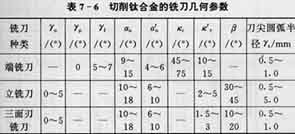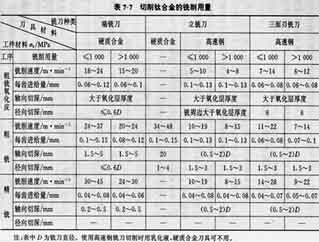Lorsque l'alliage de titane est broyé à basse vitesse dans un gaz inerte, le coefficient de déformation par fraisage est supérieur à 1.0; Mais dans l'atmosphère, lorsque la vitesse de fraisage Vc=30 m/min, le coefficient de déformation des copeaux est inférieur à 1.0. En effet, les alliages de titane ont une grande affinité pour l'oxygène et l'azote présents dans l'atmosphère lors du broyage à haute température.. À l'état d'une température élevée de 800 ℃, Les chips d'alliage de titane absorbent violemment ces gaz de l'atmosphère environnante, provoquant un changement de phase et une réelongation des jetons raccourcis. Quand l'alliage de titane est fraisé, La température est très élevée et la force d'impact est importante. Le matériau dentaire de la coupe de la fraignage doit être capable de résister à la charge alternée et à bien le choc thermique. Le carbure cimenté de type YG est généralement utilisé, et l'acier à grande vitesse du cobalt et de l'aluminium peut également être utilisé.

Paramètres géométriques du frappeur de fraisage pour le moulage du titane
Les paramètres géométriques et les paramètres de fraisage des fraises en alliage en titane sont indiqués dans le tableau 7-6 et table 7-7.

Réglez la quantité de coupure de titane de fraisage
Lors de la création d'alliages de titane, Il est conseillé d'utiliser le moulin à baisse asymétrique. De cette façon, La partie de l'avant des dents de coupe loin de la pointe du coupeur contacte d'abord la pièce, et les copeaux lorsque les dents de coupe sont coupées sont très minces, Et il n'est pas facile de s'en tenir à la coupe. Avec fraisage de coupe, Le bord de la fraignage est sujette à la cote à puce. Lorsque la dent de coupe coupe à nouveau, La puce est cassée, provoquant le décollage du matériau de coupe et l'écaillage.
Le décalage E entre le coupeur d'extrémité et l'axe de la pièce peut déterminer la meilleure position où les dents de coupe du frappeur de fraisage contactent d'abord la pièce. L'épaisseur de la puce pendant le broyage ou la coupe et la coupe en hausse est généralement basée sur le décalage e =(0.04~ 0,1) faire (faire est le diamètre du frappeur final).
En raison du petit module d'élasticité des alliages de titane, Down Milling provoque une perte d'outils, qui nécessite que la machine-outil et l'outil aient une plus grande rigidité. Lors du moulage, La longueur de contact entre l'outil et les puces est courte, Et il n'est pas facile de boucler les puces. L'outil est nécessaire pour avoir une bonne résistance dentaire et un plus grand espace de maintien en puce, Sinon, le blocage des puces provoquera une usure sévère de l'outil.
 English
English العربية
العربية 中文(漢字)
中文(漢字) Čeština
Čeština Dansk
Dansk Nederlands
Nederlands Suomi
Suomi Français
Français Deutsch
Deutsch Italiano
Italiano 日本語
日本語 ಕನ್ನಡ
ಕನ್ನಡ 한국어
한국어 Português
Português Русский
Русский Slovenčina
Slovenčina Español
Español Svenska
Svenska Türkçe
Türkçe

